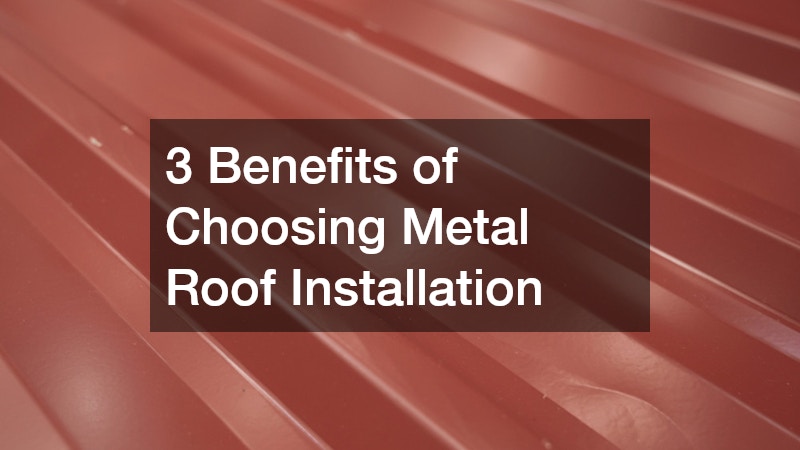
3 Benefits of Choosing Metal Roof Install
Metal roof installations have gained popularity over the years as a reliable, long-lasting solution for both residential and commercial properties. In this article, we will explore three key benefits that make metal roofs a top choice for many homeowners and builders. As the construction industry evolves, the demand for efficient and sustainable building materials continues to grow, positioning metal roofing as a favored option.
The combination of durability, energy efficiency, and environmental friendliness makes metal roofs an appealing choice for those looking to invest in their property’s future.
1. Why is Metal Roofing Considered Durable?
One of the primary reasons metal roofing is revered for its durability is its ability to withstand extreme weather conditions. Unlike traditional roofing materials, such as asphalt shingles, metal does not easily succumb to the effects of wind, rain, or hail. This resilience reduces the likelihood of frequent repairs and replacements, making it a cost-effective option over time. The natural strength of metal plays a crucial role in its ability to offer unrivaled protection against the elements, ensuring your home or building remains secure.
Another aspect of metal roofing’s durability is its resistance to fire and pests. Metals such as steel and aluminum are non-combustible, providing an added layer of safety in areas prone to wildfires. Furthermore, metal roofs do not attract insects like termites, which can wreak havoc on wooden structures. This inherent resistance to both environmental and biological threats makes metal roofing an excellent choice for long-term investment.
The longevity of metal roofs is also worth noting. A properly installed and maintained metal roof can last 40 to 70 years, far surpassing the lifespan of traditional roofing materials. This extended lifespan not only ensures that your investment remains protected for decades but also enhances the overall value of your property. The durability of metal roofing truly sets it apart as a superior choice for those seeking a robust roofing solution.
2. How Does Metal Roofing Contribute to Energy Efficiency?
Metal roofing is heralded for its exceptional energy efficiency properties, which stem from its reflective surface. This innate reflectivity plays a significant role in reducing energy consumption, particularly in warmer climates. By reflecting a significant portion of the sun’s rays, metal roofs help to maintain a cooler indoor temperature, lessening the demand on air conditioning systems and resulting in lower energy bills. This is an increasingly attractive benefit in today’s energy-conscious world.
Many metal roof installs are designed with coatings that enhance their thermal performance. These coatings further reduce the heat island effect, a phenomenon wherein urban areas become significantly warmer than their rural surroundings. By minimizing heat absorption, metal roofs help mitigate this effect and contribute to a more comfortable indoor environment. As energy costs continue to rise, the savings gained from improved energy efficiency make metal roofs a smart financial decision.
Energy efficiency in buildings has become a pivotal concern for both homeowners and commercial property owners. By choosing a metal roof, you can actively reduce your carbon footprint, benefiting not only your wallet but also the environment. The reduction in energy consumption aligns with global efforts to combat climate change, making metal roofing a fitting choice for environmentally conscious individuals.
3. What Are the Environmental Benefits of Metal Roofing?
Metal roofing is an environmentally friendly option due to its recyclability. Most metal roofs are made from recycled materials, and at the end of their long lifespan, they are fully recyclable themselves. This cyclic life process significantly reduces the amount of waste that ends up in landfills, making metal roofing a sustainable choice. Utilizing recycled materials also lessens the demand for new raw materials, further reducing environmental impact.
In addition to its recyclability, metal roofing contributes to sustainability through its energy-saving benefits, as previously discussed. These energy savings help decrease the reliance on fossil fuels, which are the primary contributors to air pollution and greenhouse gas emissions. By lowering energy consumption, metal roofs play an active role in addressing environmental challenges and advancing sustainability goals.
The manufacturing process of metal roofing systems has seen significant improvements in recent years, with many manufacturers adopting environmentally responsible practices. These include reducing emissions during production and utilizing sustainable materials. Choosing metal roofing not only supports these eco-friendly initiatives but also demonstrates a commitment to fostering a sustainable future.
Choosing a metal roof installation can provide significant benefits in terms of durability, energy efficiency, and environmental impact. While the initial cost may be higher than some other materials, the long-term savings and benefits make metal roofing a worthwhile investment. The investment is not solely monetary; it also involves investing in sustainability, safety, and the overall integrity of your building.
